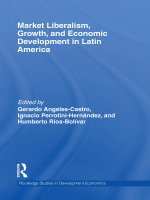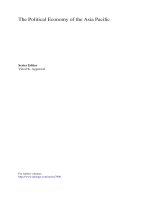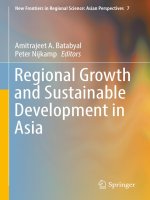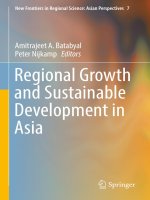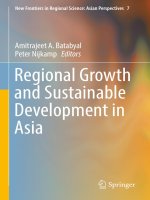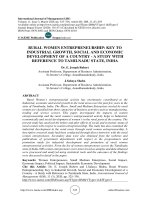Economic growth and economic development 151
Bạn đang xem bản rút gọn của tài liệu. Xem và tải ngay bản đầy đủ của tài liệu tại đây (91.68 KB, 1 trang )
Introduction to Modern Economic Growth
where Lj (S) now refers to the total employment of workers with S years of schooling
in country j.
A series for Kj can be constructed from Summers-Heston dataset using investment data and the perpetual invented method. In particular, recall that, with
exponential depreciation, the stock of physical capital evolves according to
Kj (t + 1) = (1 − δ) Kj (t) + Ij (t) ,
where Ij (t) is the level of investment in country j at time j. Let us assume, following
Hall and Jones that δ = 0.06. With a complete series for Ij (t), this equation can be
used to calculate the stock of physical capital at any point in time. However, the
Summers-Heston dataset does not contain investment information before the 1960s.
This equation can still be used by assuming that each country’s investment was
growing at the same rate before the sample in order to compute the initial capital
stock. Using this assumption, Hall and Jones calculate the physical capital stock
for each country in the year 1985. We do the same here for various years. Finally,
with the same arguments as before, we choose a value of 2/3 for α.
Given series for Hj and Kj and a value for α, we can construct “predicted”
incomes at a point in time using the following equation
1/3
Yˆj = Kj (AU S Hj )2/3
for each country j, where AUS is the labor-augmenting technology level of the United
States, computed so that this equation fits the United States perfectly, i.e., YU S =
1/3
KU S (AUS HU S )2/3 . Throughout, time indices are dropped. In the Hall and Jones
exercise, all values refer to 1985.
Once a series for Yˆj has been constructed, it can be compared to the actual
output series. The gap between the two series represents the contribution of technology. Alternatively, we could explicitly back out country-specific technology terms
(relative to the United States) as
ả3/2 à
ả1/2 à
ả
à
KU S
HUS
Yj
Aj
.
=
AU S
YUS
Kj
Hj
Figures 3.3-3.4 show the results of these exercises for 1980, 1990 and 2000.
The following features are noteworthy:
137
